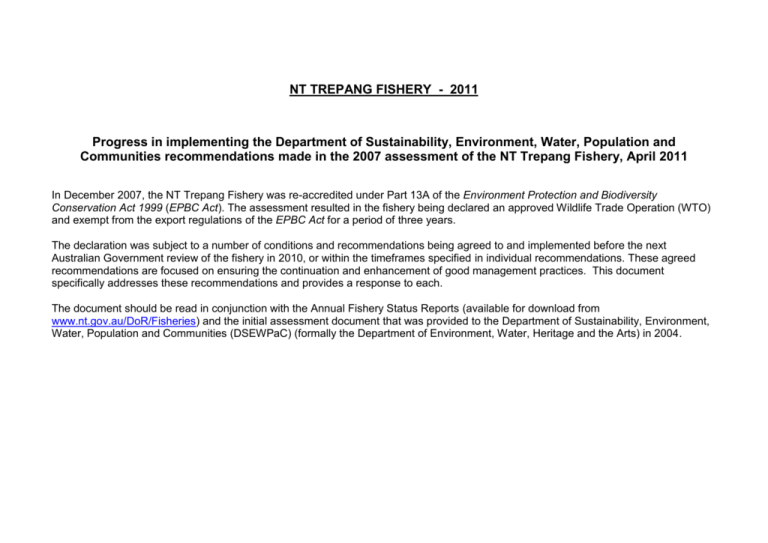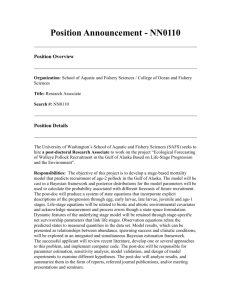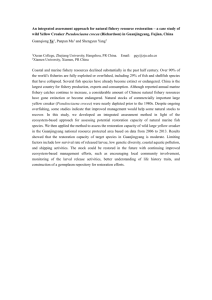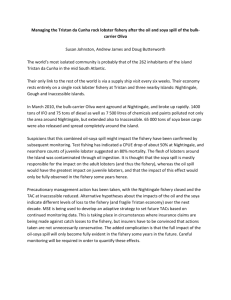Word - 84KB - Department of the Environment
advertisement

NT TREPANG FISHERY - 2011 Progress in implementing the Department of Sustainability, Environment, Water, Population and Communities recommendations made in the 2007 assessment of the NT Trepang Fishery, April 2011 In December 2007, the NT Trepang Fishery was re-accredited under Part 13A of the Environment Protection and Biodiversity Conservation Act 1999 (EPBC Act). The assessment resulted in the fishery being declared an approved Wildlife Trade Operation (WTO) and exempt from the export regulations of the EPBC Act for a period of three years. The declaration was subject to a number of conditions and recommendations being agreed to and implemented before the next Australian Government review of the fishery in 2010, or within the timeframes specified in individual recommendations. These agreed recommendations are focused on ensuring the continuation and enhancement of good management practices. This document specifically addresses these recommendations and provides a response to each. The document should be read in conjunction with the Annual Fishery Status Reports (available for download from www.nt.gov.au/DoR/Fisheries) and the initial assessment document that was provided to the Department of Sustainability, Environment, Water, Population and Communities (DSEWPaC) (formally the Department of Environment, Water, Heritage and the Arts) in 2004. The following progress has been made by DoR in implementing the DSEWPaC conditions and recommendations: Condition/Recommendation Progress Condition 1: “Operation of the NT Trepang Fishery will be carried out in accordance with the management regime in force under the NT Fisheries Regulations 1995 and the NT Fisheries Act 1988.” Condition met Condition 2: “DOR to advise SEWPaC of any intended change to the NT Trepang Fishery management arrangements that could affect the assessment of the fishery against the criteria on which EPBC Act decisions are based.” Condition met Condition 3: “DOR to produce and present reports to SEWPaC annually as per Appendix B to the 'Guidelines for the Ecologically Sustainable Management of Fisheries -2nd Edition.” Condition met The management of the Trepang Fishery is undertaken in strict accordance with the requirements and guidelines of the NT Fisheries Act 1988 and the NT Fisheries Regulations 1995. All new entries into the fishery are required to undertake an induction interview during which the regulations, licence conditions and protected species considerations are clearly outlined. DOR has kept SEWPaC informed of any proposed amendments to the management regime for the Trepang Fishery through the publication of the Current Issues and Future Plans sections in the annual Fishery Status Reports. This practice will be continued in future Fishery Status Reports and any changes to the management arrangements for the fishery will be advised to SEWPaC through subsequent annual Fishery Status Reports. In addition, DOR and SEWPaC officers have maintained informal communication channels and this has ensured that SEWPAC is kept informed of any emerging issues in the fishery. A copy of the Fishery Status Reports are provided to SEWPaC each year with a supporting document outlining progress in meeting SEWPaC’s recommendations and conditions for the fishery. Copies of the annual Fishery Status Reports are available to download at http://www.nt.gov.au/d/Fisheries/ 2 Recommendation 1: “Through continued collaboration with other jurisdictions, DoR to continue to identify and implement key research priorities regarding the biology and ecology of H.scabra.” Ongoing DoR are continuing to liaise with Queensland and Western Australia to develop ways of undertaking further cost-effective research. There are strong links between the management arrangements in WA and the NT with the fisheries being very similar in species composition and environment. Additionally, the sole operator across these areas, Tasmanian Seafoods is able to provide a good link to ensure cooperative and complimentary research across the relevant states and territories. Collaborative hatchery, growout, and broodstock husbandry research between Tasmanian Seafoods and DoR has led to the development of a commercial scale hatchery at the Darwin Aquaculture Centre. This hatchery is now capable of producing 30,000 – 50,000 juvenile sandfish in regular production runs. Complimentary pond grow-out trials indicate sandfish are capable of reaching market size in 12 months. Collaborative work between Tasmanian Seafoods, Flinders University, the South Australian Research and Development Institute and DoR is continuing on a genetic study titled ‘Population genetic structure of Sea Cucumbers (bêche-de-mer) in Northern Australia’. Spatial sampling of genetic stocks has been carried out across 15 sites in the NT and development of the genetic markers has progressed well. Initial analysis has shown some slightly unexpected results; this will be resolved with continued temporal sampling and analysis of genetic data from single pair matings through the hatchery. The results of this project will determine the genetic structure of trepang stocks in NT waters, and assist in identifying if there are geographically distinct populations within the fishery. Tasmanian Seafoods also undertook a pilot survey of sandfish stocks using a “stalled plate” trawl gear in 2009. Results from this survey were inconclusive due to survey design and technical difficulties. However, sandfish have previously been successfully sampled in the NT using smaller versions of similar gear deployed from smaller vessels. Tasmanian 3 Seafoods is currently evaluating the existing trawl gear and survey design with a view to recommence surveys with modified gear and survey design in 2011. Despite this ongoing cooperative research, many information gaps still exist with regard to NT stocks, including life history parameters, abundance and stock structure. To date, the majority of information on hand has been provided by research undertaken on similar species in other jurisdictions. As a consequence, DoR has implemented precautionary management arrangements that include limiting the fishing area, gear type and licensed operators in the fishery (Tasmanian Seafoods currently own all six licences). Recommendation 2: “Within 2 years, DoR to commence developing meaningful precautionary yield estimates for H.scabra in the NT Trepang Fishery, with the aim to commence implementing yield estimates within three years.” Ongoing Meaningful precautionary yield estimates for the NT Trepang Fishery are not yet available due to the inconclusive results of the initial trawl survey methods. Obtaining these estimates has also been delayed by the highly variable nature of the catch and effort data in the NT Trepang Fishery. DoR fisheries scientists are currently assessing the viability of using exploitation rates of trepang populations as a surrogate for calculating yield estimates. In addition, results on the stock structure project must first be obtained to identify the exploitation rates of individual populations of sandfish. In the interim, DoR considers the current catch levels to be sustainable and the fishery not to be under threat of overfishing. Low effort levels (three active licences) across a broad geographical range provide protection from overfishing and any perceived threat to sustainability. The status of the fishery is assessed through completion of the Annual Status Report and at the annual Northern Australian Fisheries Management Workshop. As sustainable yield estimates are not currently available, key variables are monitored to ensure that conditions and trends, principally species composition, catch, effort, CPUE, areas fished, average size of trepang and licensee ownership are consistent with ensuring the sustainability of the NT trepang resources (See Table 1). As yield estimates become available, further specific indicators and triggers can be developed 4 to monitor the performance of management objectives. In the interim, precautionary management arrangements adopted by DoR ensures that there is a high probability of the fishery not exceeding sustainable harvest levels, acknowledging that historical limits were a significant magnitude higher than current catch. Recommendation 3: “Using information and research relevant to the fishery, DoR to review the current limit reference points for H.scabra, to ensure that they provide a precautionary basis to detect changes and impacts on the stock.” Complete DoR researchers and managers, together with industry representatives, have reviewed the current limit reference points for sandfish to determine if they are providing a precautionary basis to detect changes and impacts to the target stock. The review included the latest available literature and known research, and the biological characteristics of the target species. The review determined that the multi-faceted approach DoR is presently employing ensures the general health of the fishery. The current limit reference points are considered sufficiently precautionary in making certain the fishery will continue to be managed in a manner that will not lead to over-fishing. The limit reference points and a brief description of recent developments are as follows: 1. Triggers to be refined when yield estimates are developed. At present the triggers cannot be refined as valid yield estimates for target species have not been developed. The research program has been unable to provide meaningful yield estimates to date as a result of the highly variable catch and effort information and technical difficulties encountered during the trawl surveys. However, continued collaborative research between Tasmanian Seafoods and DoR are working towards obtaining this information. 2. Total catch increases to over 300 t/year. 5 The 2009 catch was 52.3 tonnes, well below the trigger of 300 tonnes. As above, until information from the research and monitoring program is available to refine the trigger, the trigger of 300 tonnes is considered to be a suitably precautionary figure based on high historic catch levels. The relatively low harvest level in 2009 is attributed to a business decision by the trepang fishery licensee to concentrate available effort in other jurisdictions, and a reflection of the difficulties in recruiting and retaining experienced divers and skippers to work in the fishery. During this time Tasmanian Seafoods also directed some resources to the ranching and aquaculture of trepang. It is noted that whilst the 2009 harvest falls well short of the trigger of 300 tonnes, not all licences are currently active in the fishery and the trigger level is to allow for expected sustainable growth within the fishery. 3. The rolling three year average CPUE varies by a factor of 30%. Fluctuations in CPUE are expected in a developing fishery and can occur for reasons unrelated to changes in trepang biomass (e.g. interannual fluctuations in water clarity, prevailing weather conditions and skipper experience). To even out these variations it is considered appropriate to smooth these perturbations by averaging CPUE over the last three reporting periods and basing any trigger on those figures. Again, during the developmental phase it is more appropriate to look for trends or downswings such as occurred in Torres Strait and Great Barrier Reef (GBR) trepang fisheries. As such, the interim trigger point is set so that if there is variation of 30% on the three year average CPUE, a review of management arrangements will occur and appropriate remedial action undertaken (Table 1). The 2009 CPUE value was 3% higher than the rolling three year average, therefore the trigger reference point was not reached. The department will continue to monitor the CPUE of trepang in the 6 fishery. 4. Weighted average decreases by more than 20%. The average weight of trepang harvested since 1997 has remained relatively constant. A decline in the average weight is considered an appropriate trigger as this may indicate a reduction in the average size of individuals in the population. As such, a trigger will be activated if the weighted average of H. scabra decreases by more than 20% (Table 1). The average individual weight increased by 35% in 2009, therefore the trigger reference point was not reached. The department will continue to monitor the average size of trepang in the fishery. 5. Catch of trepang species other than H. scabra increases to over 30% of total catch. Based on occurrences in other jurisdictions a change to targeting other or lower grade species has often preceded a collapse, or could be considered as evidence of overfishing in the fishery. As such, it is considered prudent to retain a trigger that will be activated if the catch of species other than H. scabra increases to more than 30% of the total catch (Table 1). H. scabra currently makes up 100% of the reported catch. No other species of trepang were recorded as harvested over the reporting period. 6. Any licences traded. The NT Trepang Fishery has stable licensing arrangements with Tasmanian Seafoods currently owning all licences. This company also has trepang access rights in other jurisdictions (WA, Qld and the Coral Sea) and spreads its fishing resources throughout these areas. 7 Consequently, there is no “Gold Rush” mentality within the NT industry as there would be little benefit in overexploiting the resource for short term gain. However, if licences were traded the same level of resource stewardship may not necessarily be evident. It is therefore considered prudent to retain a trigger that will be activated if any licences are traded (Table 1). No licences were traded over the reporting period. The research and monitoring project being developed for the NT Trepang Fishery aims to provide further information that will help refine these trigger points through a robust and scientifically validated process. When additional information becomes available, more specific indicators and triggers will be developed to monitor the performance of management objectives. Recommendation 4: “Within 12 months, DoR to develop and implement appropriate data collection, reporting and management measures to mitigate the risk of localised and serial depletion.” Complete Logbooks have been amended and now record harvest areas in GPS coordinates. This has allowed the collection of finer spatial data to mitigate the risk of localised or serial depletion. Additionally, the NT Manager for Tasmanian Seafoods has developed a harvest area rotation roster for skippers. This has been done to maintain high catches however it will also assist in guarding against potential localised depletion. Recommendation 5: “Within 2 months of a species other than H. scabra being harvested in the fishery, DoR to develop precautionary reference points for that species.” Ongoing H. scabra is currently the exclusive target species in the fishery and there are no records of species other than H. scabra landed for the fishery. If sufficient quantities of other species become available and they can be harvested sustainably in economic quantities, then a species-specific interim reference point for that species will be developed. 8 9 Table 1: Species/Group Management Objectives, Performance Indicators, Interim Trigger Points and Management Actions Used in the NT Trepang Fishery Management objectives Target species Ensure intergenerational equity by maintaining ecologically sustainable annual catches in all sectors Performance indicators Interim Limit reference point Management response to be taken 1. Sustainable yield estimates developed 2. Change in total catch 1. Triggers to be refined when yield estimates developed 2. Total catch increases to over 300t/year. 3. The rolling three year CPUE average varies by a factor of 30%. 4. Weighted average decreases by more than 20%. 5. Catch of trepang species other than H. scabra increases to over 30% of total catch. 6. Any licences traded. NA - no byproduct in fishery NA 3. Change in CPUE 4. Change in average weight 5. Change in catch composition 6. Change in licence ownership Byproduct & bycatch species Ensure sustainability of byproduct and bycatch species taken in the NT Trepang Fishery Monitoring logbooks Director to be notified within 60 days if trigger reached An internal examination of cause and implication of reference point being triggered with report prepared within six months to Director Consultation with industry and other stakeholders on need for alternate management strategy or action if necessary and agreement on line of action If appropriate, any amended arrangements to be implemented within 12 months of trigger being reached Onboard monitoring 10





